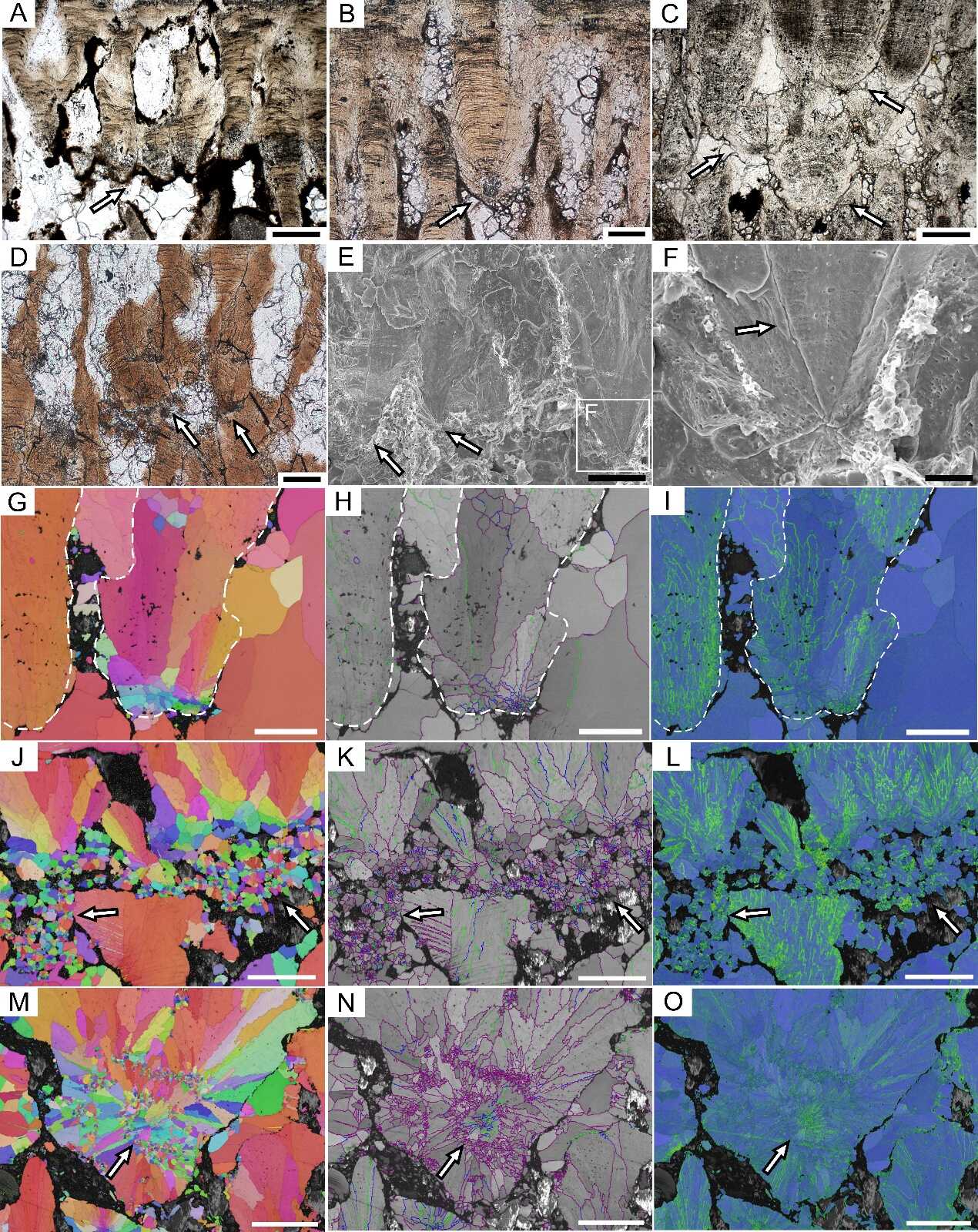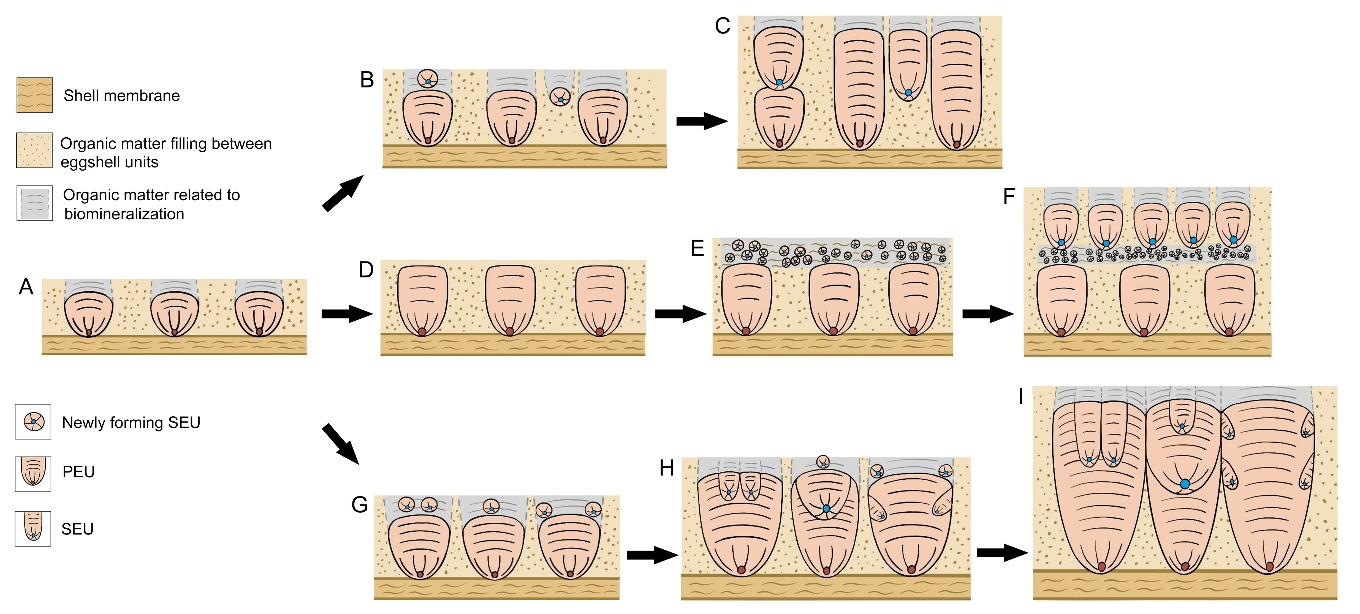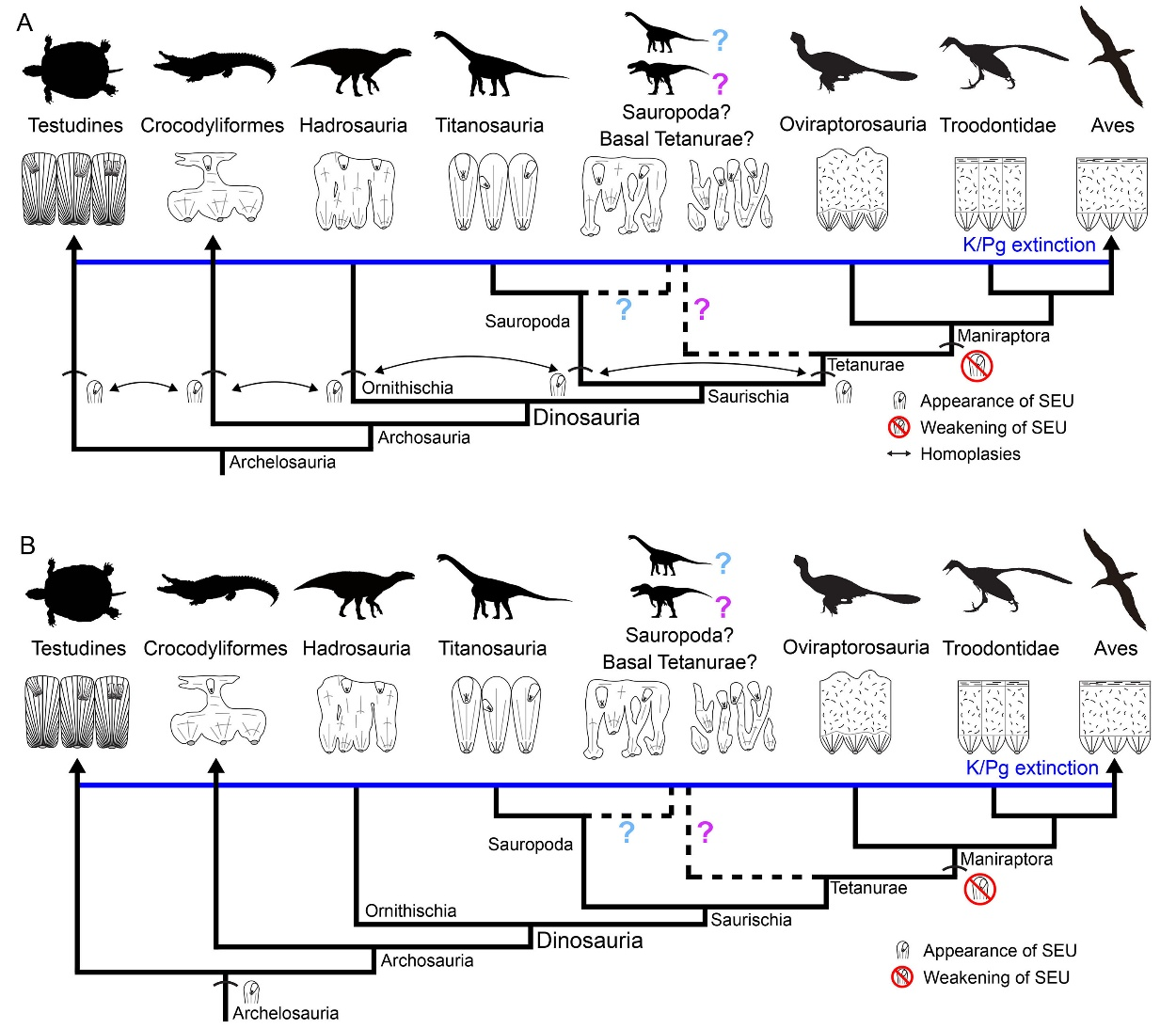Secondary eggshell units in dinosaur eggshells
The calcitic layers of the eggshells of archosaurs (including crocodilians and birds) and turtles are composed of eggshell units. Those growing from the shell membrane are called primary eggshell units (PEUs), while those growing within the calcitic layer are called secondary eggshell units (SEUs). Although extremely rare in modern bird eggs, SEU is a common feature in dinosaur eggs. Due to the lack of in-depth research on this structure, whether it is biogenic or abiogenic is still debatable.
Recently, an international team led by Senior Engineer Shukang Zhang and postdoctoral researcher Seung Choi (now a research professor at Seoul National University) from the Institute of Vertebrate Paleontology and Paleoanthropology (IVPP), Chinese Academy of Sciences, conducted a comprehensive study on the SEUs of dinosaur eggshells using techniques such as electron backscatter diffraction (EBSD), polarized light microscopy (PLM), and scanning electron microscopy (SEM). For comparison, they also examined some eggshells of modern birds, turtles, and crocodiles.
The results revealed that the crystallographic characteristics of the SEUs in dinosaur eggs were almost identical to those of the PEUs. More importantly, they also matched the crystallographic characteristics of the SEUs in modern turtle and crocodile eggshells. Additionally, the SEUs in dinosaur eggs exhibited numerous grooves and pores, similar to those in modern bird eggshell units. These grooves and pores were the spaces left by the degradation of organic matrix fibers during fossilization. These results indicate that the SEUs in dinosaur eggs are biogenic structures.
Furthermore, in some dinosaur eggshells with well-developed pore canals, SEUs either overlapped on PEUs or grew inside the pore canals. Although the growth of these SEUs was undisturbed, the c-axes of their calcite crystals still extended parallel to the growth direction of the eggshell. This phenomenon challenges the "competition hypothesis" derived from modern bird eggshells, and reveals that the c-axis orientation of eggshell units is controlled by organic matrix fibers, rather than the result of the competitive growth between adjacent calcite crystals.
The dinosaur eggshells attributed to sauropods, hadrosaurs, and possible basal Tetanurae possessed SEUs, whereas the eggshells of maniraptorans (including birds) rarely exhibited such structures, suggesting that the formation mechanism changed during the evolution of eggshell from non-avian theropods to modern birds. On the other hand, SEUs appear in turtles, crocodilians, as well as ornithischian, sauropod, and theropod dinosaur lineages, indicating that these structures may have evolved independently along with the calcitic layers of the eggshells. However, at the molecular level of biomineralization, the possibility of a deep homology of the SEUs across all these lineages cannot be ruled out.

The differences between the biogenic and abiogenic calcite in dinosaur eggshells: In the PLM images (A and E), biogenic calcite is dark, while abiogenic calcite is bright; On the IPF maps (B and F), the directions of the c-axes of the biogenic calcite grains are consistent (red), while various in the abiogenic calcite grains (various colors); On the BC+GB maps (C and G), biogenic calcite has textured gray scales, while abiogenic calcite has plain gray colors; On the KAM maps (D and H) , biogenic calcite has high KAM values (green), while abiogenic calcite has low KAM values (blue). SEM (I and J) and TEM (K) images show that biogenic calcite has growth lines (arrows) and porous structure. In the CL images (L—N), SEUs are dark or have orange fluorescence, indicating that CL is not an effective method for the identification of biogenic calcite. Scale bars are equal to 200 μm (A, B, E, and F), 100 μm (C, D, G, H, and N), 50 μm (I),15 μm (J), 500 nm (K), and 150 μm (L and M).

SEUs of the highly porous dinosaur eggshells. A—D: PLM images;E, F: SEM images;G—O: EBSD images. The SEUs have radially arranged c-axes (G, J, and M), textured gray scales (H, K, and N), and high KAM values (I, L, and O). The arrows show the grooves and vesicles in F, show the SEUs in other images. Scale bars are equal to 200 μm (A and C), 100 μm (B, D, E, and G to O), and 25 μm (F).

Formation mechanism of dinosaur eggshells containing SEUs. B—F: Highly porous eggshells, SEUs are superimposed on PEUs, inside pore canals (B and C), and form layers (E and F);G—I: Moderately porous eggshells. SEUs are mostly embedded in PEUs and other SEUs.

SEUs gradually decline in the maniraptoran eggshells. The SEUs of turtle, crocodilian, ornithischian dinosaurs, sauropod dinosaurs, and theropod dinosaurs might result from parallel evolution (A), or might have a deep homology (B).
Download attachments: